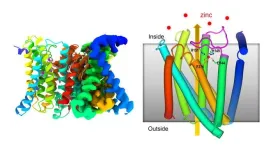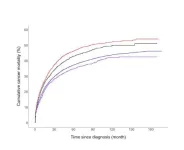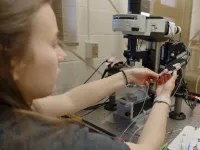(Press-News.org) In a study published online in Nano Letters, the team led by Prof. LI Chuanfeng and Dr. XU Jinshi from the University of Science and Technology of China of the Chinese Academy of Sciences made progress in enhancing the fluorescence of single silicon carbide spin defects. The researchers leveraged surface plasmons to markedly boost the fluorescence brightness of single silicon carbide double vacancy PL6 color centers, leading to an improvement in the efficiency of spin control using the properties of co-planar waveguides. This low-cost method neither calls for complex micro-nano processing technology nor compromises the coherence properties of the color centers.
Spin color centers in solid-state systems are crucial for quantum information processing, and the brightness of their fluorescence is a vital parameter for practical quantum applications. Traditionally, enhancing the fluorescence of spin color centers involves coupling them with solid-state micro-nanostructures, a common method encompassing various schemes such as the fabrication of solid immersion lenses, nanopillars, bull's eye structures, photonic crystal microcavities, and fiber cavities. Nevertheless, challenges remain such as the susceptibility of color center spin properties to complex micro-nano fabrication processes, and the difficulty of aligning specific color centers with micro-nano structures.
Pioneering a new approach, the team used plasmons to enhance the fluorescence of spin centers in silicon carbide. The researchers prepared a silicon carbide thin film of about 10 micrometers in thickness via chemical and mechanical polishing. They used ion implantation technology to create near-surface divacancy color centers in the film. The film was flipped and adhered to a silicon wafer coated with a coplanar gold waveguide, utilizing van der Waals forces. This positioning allowed the near-surface color centers to come under the influence of the surface plasmons of the gold waveguide, thereby enhancing the fluorescence of the color centers.
With an objective lens (with a numerical aperture of 0.85) and the enhancement effect of surface plasmons, the researchers achieved a seven-fold enhancement of the brightness of a single PL6 color center. With an oil lens with a numerical aperture of 1.3, the fluorescence of the color center exceeded one million counts per second.
Besides, the researchers managed to precisely manipulate the distance between the near-surface color center and the coplanar waveguide by adjusting the film thickness with a reactive ion etching process, which allowed them to study the optimal range of operation. Apart from generating surface plasmons, the coplanar gold waveguide can be used to efficiently radiate microwaves, significantly improving the efficiency of spin control. The coplanar waveguide increased the Rabi frequency of a single PL6 color center by 14 times under the same microwave power compared with that in conventional microwave radiation methods.
Moreover, the researchers investigated the mechanism of fluorescence enhancement. By fitting the autocorrelation function using a three-level model and measuring the non-resonant excitation fluorescence lifetime, they confirmed that surface plasmons enhanced the fluorescence brightness by increasing the radiative transition rate of the color center energy level. They also found that as the interaction distance decreased, the quenching effect of surface plasmons resulted in a decay in the fluorescence brightness of the color center.
This work marks the first implementation of plasmon-enhanced fluorescence from near-surface spin color centers in silicon carbide films. The preparation of the coplanar gold waveguide is straightforward without intricate enhancement structures or alignment processes. This method also enhances the fluorescence of other spin color centers in silicon carbide, representing a significant step forward in applying silicon carbide materials to the field of quantum science.
END
USTC enhances fluorescence brightness of single silicon carbide spin color centers
2023-06-09
ELSE PRESS RELEASES FROM THIS DATE:
Researchers determine quantitative composition of ultrahigh-pressure fluid in deep subduction zones
2023-06-09
In a study published in PNAS, Prof. XIAO Yilin’s group from the University of Science and Technology of China (USTC) of the Chinese Academy of Sciences (CAS) quantitatively determined, for the first time, the chemical composition of supercritical fluids in deep subduction zones, through 3D imaging modelling of ultrahigh-pressure (UHP) multiphase fluid inclusions, and revealed the important role of supercritical fluids in the cycling of carbon and sulfur in subduction zones, which is of great importance ...
USTC reveals reconfiguration process of solar eruptions
2023-06-09
Recently, a research team led by Prof. GOU Yanyu from the University of Science and Technology of China (USTC) of the Chinese Academy of Sciences (CAS) found that the solar outburst structure undergoes a complex reconfiguration evolution during the early outbursts, thus making important advances in the study of solar outburst activity. This study was published in Nature Astronomy.
In classical images, the core structure of a solar eruption is a magnetic rope consisted of spirally wound magnetic lines. When the eruption begins, the magnetic ropes around the core are transformed by magnetic reconnection ...
DNA facilitates escape from metastability
2023-06-09
Prof. LIANG Haojun from the University of Science and Technology of China (USTC) of the Chinese Academy of Sciences (CAS) proposed a new method to escape from metastability for self-assembly in a far-from-equilibrium system. The study was published in PNAS.
Self-assembly refers to the process in which assembled primitive elements (molecules, nanoparticles, etc.) spontaneously form ordered structures through non-covalent interactions. Its excellent capacity to create new materials has drawn attention. In an ...
Single quantum bit achieves complex systems modeling
2023-06-09
A team led by Academician GUO Guangcan from the University of Science and Technology of China (USTC) of the Chinese Academy of Sciences (CAS), with collaborative efforts from the University of Manchester, and Nanyang Technological University, has achieved new progress in applying quantum technologies in complex systems modeling. The results were published in Nature Communications on May 6.
Stochastic modeling can help us to predict the future behavior of complex processes, which are non-Markovian. In order to simulate a non-Markovian process, a memory is of necessity to store a large amount of observed information about the past of the system. However, ...
Zinc transporter has built-in self-regulating sensor
2023-06-09
UPTON, NY — Scientists at the U.S. Department of Energy’s (DOE) Brookhaven National Laboratory have determined the atomic-level structure of a zinc-transporter protein, a molecular machine that regulates levels of this crucial trace metal micronutrient inside cells. As described in a paper just published in Nature Communications, the structure reveals how the cellular membrane protein shifts its shape to move zinc from the environment into a cell, and temporarily blocks this action automatically when zinc levels inside the cell get too high.
“Zinc is important for many biological ...
New model offers a way to speed up drug discovery
2023-06-09
CAMBRIDGE, MA — Huge libraries of drug compounds may hold potential treatments for a variety of diseases, such as cancer or heart disease. Ideally, scientists would like to experimentally test each of these compounds against all possible targets, but doing that kind of screen is prohibitively time-consuming.
In recent years, researchers have begun using computational methods to screen those libraries in hopes of speeding up drug discovery. However, many of those methods also take a long time, as most of them calculate each target protein’s ...
Black, Hispanic survivors of breast cancer have higher death rates from second cancers
2023-06-09
Hispanic and non-Hispanic Black female survivors of breast cancer experience higher death rates after being diagnosed with a second primary cancer than members of other ethnic and racial groups, according to recent research from investigators at the Johns Hopkins Kimmel Cancer Center.
In a study of nearly 40,000 adult survivors of breast cancer, the risk of death from a second cancer was 12% higher among non-Hispanic Black survivors and 8% higher among Hispanic survivors compared with non-Hispanic white survivors. Survivors in racial and ethnic minorities were diagnosed with second cancers ...
Mouse models of adolescent binge drinking reveal key long-lasting brain changes
2023-06-09
UNIVERSITY PARK, Pa — Heavy alcohol consumption may cause permanent dysregulation of neurons, or brain cells, in adolescents, according to a new study in mice. The findings suggest that exposure to binge-levels of alcohol during adolescence, when the brain is still developing, lead to long-lasting changes in the brain’s ability to signal and communicate — potentially setting the stage for long-term behavioral changes and hinting towards the mechanisms of alcohol-induced cognitive changes in humans.
“What we’re seeing here,” said Nikki Crowley, assistant professor in biology and biomedical engineering ...
Infants and toddlers up to 5 years old can participate in Shape Up! Keiki study at Pennington Biomedical
2023-06-09
The Pennington Biomedical Research Center is looking for children 5 years old and younger to participate in the Shape Up! Keiki research study. The purpose of the Shape Up! Keiki research study is to create a better way to measure and describe health from body shape.
“Parents can learn more about their child’s health by joining the Shape Up! Keiki study, while also providing important information that will help us find quick ways to measure obesity status and health based on a child’s body ...
Seenu Hariprasad named University of Chicago Chair of Ophthalmology and Visual Science
2023-06-09
Seenu M. Hariprasad, MD, the Shui-Chin Lee Professor of Ophthalmology, will be appointed Chair of the Department of Ophthalmology and Visual Science, effective July 1, 2023. He has been serving as Interim Chair since 2020.
Hariprasad is an internationally recognized vitreoretinal surgeon who originally joined the University of Chicago in 2005. Over the course of his career, he has developed a strong track record as a clinician, surgeon, researcher, educator, and leader in his department. He is a leading specialist in various vitreoretinal disorders, including macular degeneration, diabetic ...




